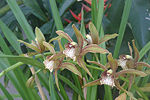Cymbidium
| Cymbidium |
|---|

|
| Scientific Classification |
|
| Species |
|
Cymbidiums are a very popular Orchids because of their beauty and how they can grow in the cold. Cymbidiums have been around for thousands of years and are native to the far east, but through the centuries people have carried them west. And according to Confucius they are the king of fragrance.[1]
Anatomy
Cymbidiums vary in size and can blossom from 1in - 5in. They come in every color except blue and true red. They usually have 10 - 20 flowers. They have 3 sepals that look like petals. One dorsal and 2 lateral; usually the same size. They always have 3 petals. Two that are normal and one that is a lip. [2]The lip serves as a landing platform for pollinators and is highly specialized. They also have a finger-like column that holds the reproductive organs. It has a short, thick stem that stores water and minerals. The stem is also called the pseudobulb. The leaves can be thick and leathery, but mostly they are flexible with prominent ribs. They have thin vascular tissue. They have 1 or 2 spikes near the base of the stem. The roots are thick, spongy and are covered with white velamen.
Reproduction
Cymbidiums reproduce just like other plants in that they have the male pollen transferred, usually by animals, to the female ovary. Then an embryo forms and the seed is planted and then begins to grow. The seeds are 0.5 - 1.9mm long, with spherical embryos.[3] They need lots of sun and water to grow; they grow on trees and rocks without their roots being supported by soil. One species called Macrorhizon grows underground and is not visible until it's flower spikes pop out. The anther has 2 pollen or 4 fused together in 2 sections. [4] A lot of people make beautiful hybrids by mixing certain species of cymbidiums. They bloom once a year and the flowers last more than a month. If the plant is healthy it will have 1 or 2 bulbs appear from each bulb that grew the previous year.
Ecology
Cymbidiums are, all over the world, desired for their beautiful flowers. They are used for medical sources. Cymbidiums are native to Asia and Australia. Then they were made popular in Europe during the Victorian era. But people had been growing them since 500 BC.;[5] we know because Confucius wrote that he thought that the Asian Cymbidium was the king of fragrance. Internationally, today, they are the highest price per flower. There are also a lot of beliefs about Cymbidiums. [6] In Asia it is a symbol of honor to give or receive it. Enthusiasts believe it symbolizes virtue and morality. In ancient times, the Asian Cymbidium was a gift of respect and friendship.
Plant Care
Cymbidiums are one of the easiest orchids to grow because of their ability to grow in the cold. They grow best in 50% humidity, with lots of strong sunlight. Don't try to grow it inside. They can get infections; mealybugs and scale insects are sometimes attracted to them. Four weeks after all the flowers have fully bloomed cut off the spikes. You should re-pot them every 2 - 4 years. [7] When you re-pot, tease the roots apart and remove any dead roots. Water them regularly in the growing season. To keep it in the best shape, feed it orchid fertilizer once a month, during the summer. The plants can stay strong through temperatures to 28 degrees F.;[8] although the spikes are more delicate.
Gallery
References
- Cymbidium Wikipedia.
- cymbidium The Flower Expert.
- the genus Cymbidium ionopsis.com.
- orchids books David & Cribb, Phillip. Kew Publishing.
- Linda's Orchid Pages Linda. Orchid Lady.
- Harnessing the economic potential of orchids in the Uttaranchal Ajay Kumar Singh, Rakesh Mer and C. Tiwari. G. B. Plant Institute of Himalayan Environment and Development.
- Cymbidiums Orchids Herbs2000.com


